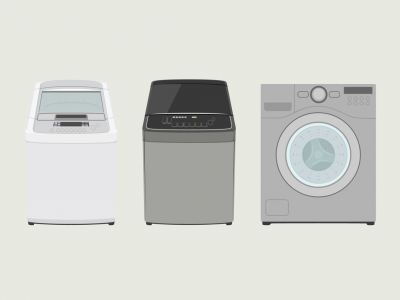
Should You Buy a Top or Front Load Washing Machine?
What type of washing machine is best for you? The answer depends on your preferences, budget, and your laundry area space.
Among top-loading washing machines, there are two primary options. Old school agitator styles with a rotating pole in the drum center are still the most popular type of washing machine. Newer, high-efficiency (HE) top-loaders rely on an impeller pump in the drum base to help turn and clean the clothes.
Front-load machines began appearing in the U.S. in the 1990s and rapidly gained popularity, although they were already the dominant style in Europe and other parts of the world.
If you want to invest in a new washing machine, consider these trade-offs:
Purchase Cost
Top-loading agitator-style washing machines are available across a wide range of price points, but they’re often less expensive than HE top-loading and front-loading machines.
However, if you’ll be using your washer for years, it’s wise to look beyond the purchase price. Agitators can be rough on clothing, causing more wear and tear during the wash cycle, so you may need to replace some items.
Also, consider how much it will cost to operate your washing machine in terms of the amount of energy and water it uses.
Cleaning and Protecting Your Clothes
According to Consumer Reports and Reviewed.com, front load machines usually earn the highest ratings for performing a washing machine’s primary job—getting clothes clean. While many top load units receive good marks for cleaning clothes, you may need to pretreat stains or add laundry boosters to improve results.
Front-loaders wash clothes more gently than most top-loaders. They also use less water and extract more of it, reducing drying times and the corresponding wear and tear on clothing. For preserving the life of your clothing, front-loaders win.
Length of Wash Cycles
Agitating top load machines are the clear winner on this issue. When Consumer Reports ran wash cycles with comparable settings (normal wash/heavy soil), they found that most agitator washers completed the cycle in 35 to 65 minutes. In contrast, HE top-loaders required 60-80 minutes, while front-loaders spent a whopping 75-120 minutes per load.
It’s worth noting that reduced drying time for clothes washed in front-loading models may offset their longer wash cycles. Still, it’s a dramatic difference in the time required to wash a load of clothes.
Noise Level
Agitating top-loaders are typically the loudest option, while HE top-loaders tend to be quieter, and front-loaders make the least noise. If your washer is located away from your living space, noise may not be an issue. But a loud washing machine near your bedroom could make it difficult to get a good night's sleep.
Out-of-Balance Loads
A lopsided load of laundry can force all types of washing machines to hit the pause button. Top load agitators are most likely to encounter this problem. HE top-loaders do a better job of balancing loads on their own by adding water and improving circulation.
Front-loading styles also encounter occasional out-of-balance issues, although the drum’s horizontal rotation significantly reduces the likelihood of encountering error messages.
Convenience and Maintenance
If you like the convenience of dropping an extra item or two into your washer after the cycle has begun, a top load machine is your friend. Since front-loading washers are mounted horizontally, it’s impossible to open the door once a wash cycle has begun unless you're willing to wait for the water to drain below the drum before the door is unlocked.
Also, routine maintenance tends to be lower for top-loading than front-loading models, especially in terms of keeping the drum smelling fresh and preventing mold growth—a common complaint about front load machines.
Saving Water and Energy
In terms of energy and water conservation, front load washers are the winners, out-performing even HE top-loading models. Also, since front-loaders use the least amount of water and remove more water in the spin cycle, the energy savings extend to shorter drying cycles.
The Largest Payload
HE top-loading models usually include the largest drum sizes, making them one of the best options for washing oversized laundry loads. But keep in mind that a larger drum size can make it difficult to reach the bottom and retrieve small laundry pieces.
Traditional top load washers tend to have the smallest tub capacities, but some manufacturers do offer large-capacity versions.
Space and Configuration
Ultimately, your choice of washer style may depend on how much space you have and how you want to arrange your equipment. If you want a larger capacity machine, be sure to check the unit’s overall dimensions. Some large-capacity washers are wider than the standard 27 inches.
Also, consider how you’ll arrange your washer and dryer. Front-load washers are only hinged on the left, whereas most dryers can be hinged either way. In a side-by-side configuration, you’ll want the washer on the left and the doors swinging in opposite directions, so it's easier to move clothes between the washer and dryer. If the units will be stacked, it’s better to hinge both doors on the left.
Your Final Decision?
No washing machine can be all things to all people. But if you prioritize what matters most to your family and consider any limitations like space, you can find a machine that works well for you and yours.
